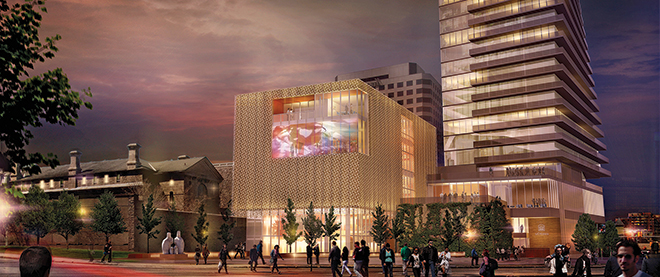Ottawa Art Gallery’s valuable collection gets a new home
The simple, functional space forgoes starchitecture trends
Barry Padolsky Associates Inc. Architects/KPMB Architects
Share

In a city whose arts scene is dominated by national museums, the Ottawa Art Gallery has existed in the shadow of its more famous, and federally funded, cousins. It is one of the country’s smallest local galleries, but also home to one of our most important private collections. The 1,614 works by iconic artists such as the Group of Seven, Emily Carr, David Milne and Norval Morrisseau were donated by art connoisseur O.J. Firestone, father of Ottawa Senators founder Bruce Firestone.
But while the gallery has carved out a reputation around Ottawa—both Rideau Hall and the Senate have borrowed from its collection —it has spent its entire 25-year history crammed inside a former county courthouse. “The building was designed for judges and policemen and, in some cases, criminals,” says gallery CEO Alexandra Badzak. Some pieces are displayed inside former holding cells.
Last month the city government approved plans for a new gallery, triple the size of the existing one, as part of its $34-million redevelopment of the downtown Arts Court, set to be finished in 2016. In doing so it hopes to revive a lost chapter in the architectural history of a city where buildings tend to be divided between the monumental and the bureaucratically efficient. The vision is to recreate O.J. Firestone’s original home, a 7,000-sq.-ft. modernist concrete box that became a fixture on the local art scene when it was built in 1961 in the upscale Rockcliffe Park neighbourhood. Firestone developed close relationships with many of the artists whose work he displayed. He hosted lectures in the teak-panelled salon and gave guided tours of the collection, some of which hung in bathrooms and bedrooms. “We play this little game of six degrees of separation to the Firestone family,” Badzak says. “Almost everybody you talk to of a certain generation was in that Firestone home.”
Before his death in 1993, Firestone donated both house and collection to the provincial heritage foundation. The art ended up with the city, while the home was left vacant. It was finally torn down in 2007, although the gallery was able to salvage some parts. “When you take the artwork out of the container, something fundamental changes,” says Carleton University of Ottawa architecture professor and gallery board member Ben Gianni. “We’ve always been uncomfortable with the fact that the collection got separated from the house.”
The home’s marble staircase will be the focal point of the lobby of the new 42,000-sq.-foot building, leading to a dedicated Firestone gallery, a wood-panelled cube designed to resemble the salon. The idea of replicating the salon’s floor-to-ceiling windows was rejected in order to protect the art from natural light. The gallery will instead install large windows in a room dedicated to contemporary exhibitions designed to be seen from the street. The original house was wrapped in a perforated concrete screen that covered some windows, lighting the art with diffused and patterned sunlight. Likewise, the new gallery will be wrapped in a semi-transparent metal skin. “Our idea was to use the pattern of it to create a veil that floats on the outside of the actual building,” says architect Mitchell Hall, of Toronto firm KPMB Architects.
As it happens, the gallery is playing into an architectural trend. After decades of experimenting with designs so elaborate they often overshadowed the building’s contents, North American museums are heading back to their roots as simple, functional spaces. Celebrity architects like Frank Gehry and Daniel Libeskind, who designed expansions of the Art Gallery of Ontario and the Royal Ontario Museum, respectively, have shifted their gravity-defying visions to Toronto’s condo market. Meanwhile, the most lauded new museum of the past few years was the Barnes Foundation, which opened a gallery for its $25-billion collection in Philadelphia last year. Critics praised the simplicity of its Lego-block design for paying tribute to the foundation’s original home.
In a similar way, the Ottawa Gallery is recreating its residential origins. “The job of a municipal art gallery is to bring people into connection with art in the best way possible,” says Badzak. “A lot of these ‘starchitecture’ spaces are not necessarily about those elements. We’re trying to bring it back to its primacy.”